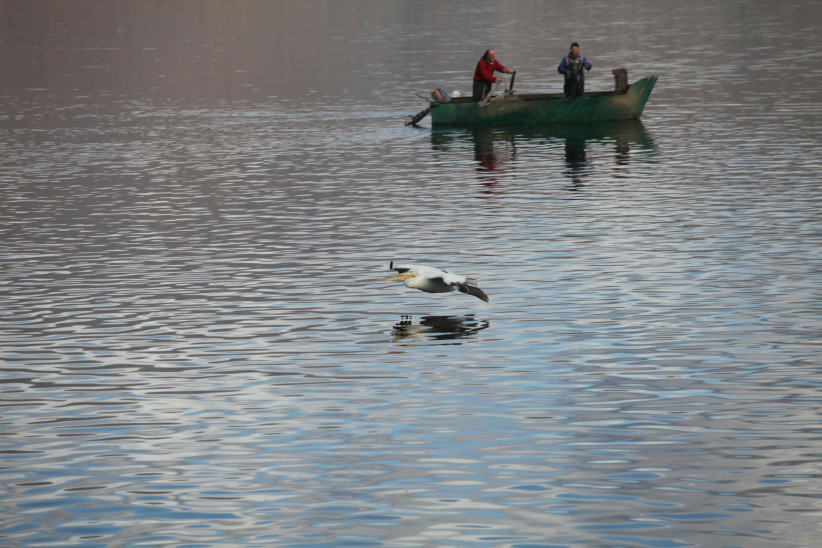In the past, the lake was frozen for about 15 days of each winter, and the ice was so thick that they were passing over to the carts loaded over it
By Nicolas Bard
Lake Kastoria, also known as Lake Orestiada, is located in western Macedonia at an altitude of 630 meters and the city of Kastoria is built in its middle. It is the eleventh largest largest lake in our country, reaching a depth of up to 12 meters. The lake coastline reaches 30 km and the volume of water is 100 million cubic meters. In the old days, the lake frozen for about 15 days of each winter, and the ice was so thick that they passed over to him. Today these images are scarce, but the whole lakeside route are long natural beauty, with centuries -old plane trees, beautiful mansions (at the height of the old town of Kastoria) and many historical monuments.
Protected area
The lake is a protected location of the Natura 2000 network and is a very important area for reproductive, passive and overwhelming species, even for some predators. It has a wealthy birds, with more than 200 species of birds being found there, as well as rich fishing, making it the second richest lake in catches all over Greece. In its waters we come across the Grivadi, the Tournes, the platforms, the Gulians, the Gullies, the Perkas, the Butterflies, the Chrysus and the Tsironon.
In the northwest of the lake there is a lakeside forest of willows, poplars and cloths, in the east and south there are seasonal liquids and perimeter sprouts grow reeds from wild boar, brush and mats. The trees that dominate the lake are the plane trees, with the vegetation being complemented by elm, cranks, bombs and roses.
As can be easily understood, the rich flora of the area is the ideal refuge for birds.
The Limena Neolithic settlement of Dispilio
On the shores of the lake, near the village of Dispilio, a prehistoric lake settlement of the 6th millennium BC has been found, confirming the human facility in the area since the Neolithic period. According to Tito Livio, in the Roman era, the city of Keletron was built on its inner banks, which was renamed Kastoria during the Byzantine Empire. But apart from the city of Kastoria and the settlement of Dispioli, on its banks you can find the villages of Crepeni and Mavrochori today. The findings of the area show that for 7,000 years the prehistoric man has had the know -how to fish, to chase weapons with pioneering for his time, and to cultivate the land, with sophisticated tools, and most importantly the early writing in wood in order to meet his communication needs. Although not yet deciphered, the age of writing (5,300 BC) tends to be somehow considered a “forerunner” of Linear I.
The monastery of Panagia Mavriotissa
On the east bank of the peninsula of Lake Kastoria is built the Holy Monastery of Panagia Mavriotissa, which is dedicated to the Assumption. It is 4 km away from the city of Kastoria and was named after Mavovo. The monastery was probably built during the Middle Byzantine period. N. Moutsopoulos dated the remains of the first temple of the monastery in the 12th century. The original temple had the same dimensions as the present, consisting of the main temple and the narthex, which is lower. In a later period, a chapel was added to the south wall of the main temple, dedicated to Saint John the Theologian. The surviving buildings of the monastery include the abbot, some cells, the bell tower and the hostel. The monastery is right next to the lake and stands out for its beautiful and rare frescoes, both inside and outside the temple.
The mansions of Kastoria
Paralimnia are also built and the famous mansions of Kastoria, which belonged to the wealthy furors of the city. The old town of Kastoria is filled with Macedonian and neoclassical mansions, especially in the districts of Azari and Dolcos, specimens of the economic prosperity that the place has known. Most are built in the 17th and 18th centuries, and are three -storey or four -storey. Inside, we find elaborate wood carvings on the ceilings, rare frescoes and decorated fireplaces. On the lower floors there is the floor and the fur workshop, while on the outside the courtyards are protected from tall, stone fences. What stands out for these mansions is their balanced relationship with the environment, the sense of the measure that distinguishes them, and the harmonization with the human scale. These great buildings made with their hands Macedonians and Epirus masters, traveling to the Balkans and Asia Minor. A stroll through this picturesque area will take you, without exaggeration, to another era.
Source :Skai
I am Frederick Tuttle, who works in 247 News Agency as an author and mostly cover entertainment news. I have worked in this industry for 10 years and have gained a lot of experience. I am a very hard worker and always strive to get the best out of my work. I am also very passionate about my work and always try to keep up with the latest news and trends.












